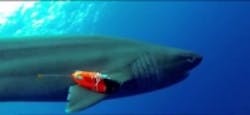By attachingvideo cameras and sensors to a number of sharks, researchers from the University of Hawaiʻi at Mānoa and the University of Tokyo have gained some insight into the habits of sharks, including feeding, social interaction, and swimming patterns.
Scientists from both universities mounted videocameras on the fins of reef sharks in Hawaii to provide more information on the ocean predators. This includes information on where they are going, how they are getting there, and what they are doing once they reach a specific destination, according to the University of Hawai’i.
"What we are doing is really trying to fill out the detail of what their role is in the ocean," said Carl Meyer, an assistant researcher at the Hawaii Institute of Marine Biology at the University of Hawaii at Manoa in apress release. "It is all about getting a much deeper understanding of sharks’ ecological role in the ocean, which is important to the health of the ocean and, by extension, to our own well-being."
By using the cameras, along with accelerometers and magnetometers, scientists were able to create the first3D map showing how sharks travel, live, and eat.
In addition, the researchers are piloting a project in which they are using instruments ingested by the sharks to make electrical measurements to track ingestion and digestion or prey, in order to help the researchers understand where, when, what, and how much sharks and other sea predators are eating.
One of the more interesting observations made by the video cameras was sharks of different species swimming together in schools and interacting with other fish and moving in repetitive loops across the sea floor. The cameras also found that sharks use a more power-based swimming motion, rather than the gliding motion that scientists previously thought sharks used.
The data gathered by the project could enable the researchers to help shape conversation and resource management efforts and inform public safety measures, according to the press release.
Editor’s note: The model and manufacturer of the cameras used in the project was not noted.
View thepress release.
Also check out:
Vision-guided underwater robot discovers sea anemones living in ice
UAVs create 3D model of the Matterhorn
(Slideshow) Robots and research: Eight examples of innovative imaging applications
Share your vision-related news by contactingJames Carroll,Senior Web Editor, Vision Systems Design
To receive news like this in your inbox,click here.
Join ourLinkedIn group | Like us on Facebook | Follow us on Twitter| Check us out on Google +
About the Author

James Carroll
Former VSD Editor James Carroll joined the team 2013. Carroll covered machine vision and imaging from numerous angles, including application stories, industry news, market updates, and new products. In addition to writing and editing articles, Carroll managed the Innovators Awards program and webcasts.
